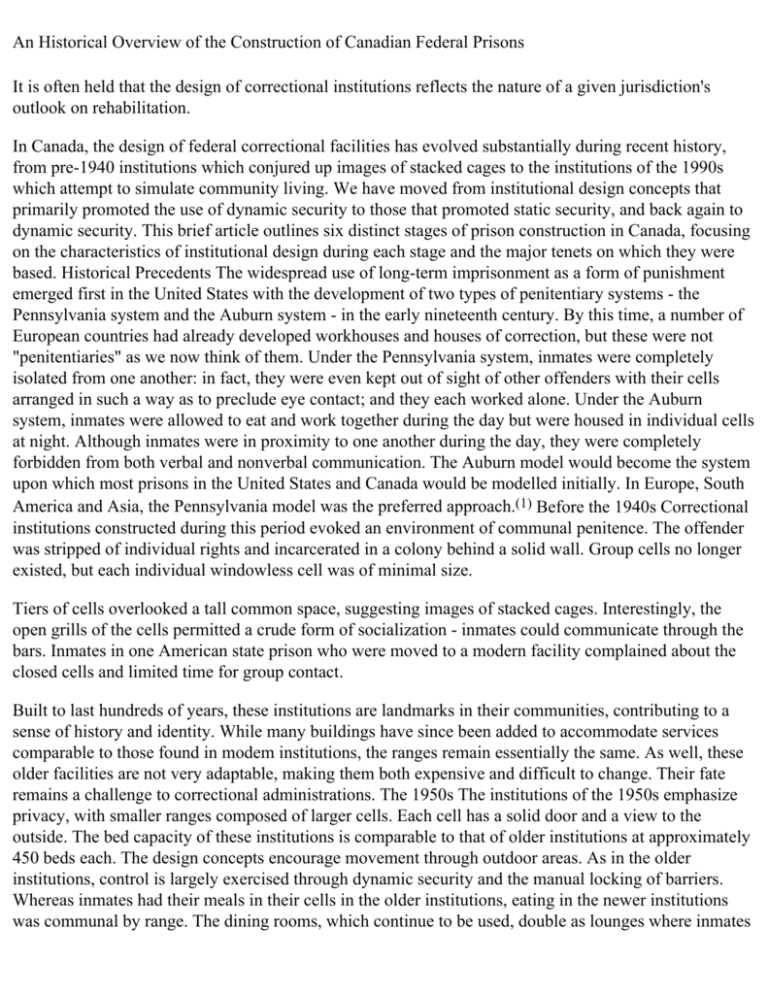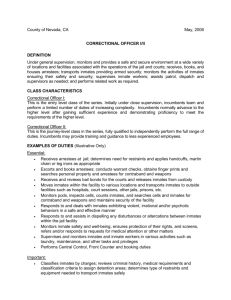Volume 3, Number 2, 1991
advertisement

An Historical Overview of the Construction of Canadian Federal Prisons It is often held that the design of correctional institutions reflects the nature of a given jurisdiction's outlook on rehabilitation. In Canada, the design of federal correctional facilities has evolved substantially during recent history, from pre-1940 institutions which conjured up images of stacked cages to the institutions of the 1990s which attempt to simulate community living. We have moved from institutional design concepts that primarily promoted the use of dynamic security to those that promoted static security, and back again to dynamic security. This brief article outlines six distinct stages of prison construction in Canada, focusing on the characteristics of institutional design during each stage and the major tenets on which they were based. Historical Precedents The widespread use of long-term imprisonment as a form of punishment emerged first in the United States with the development of two types of penitentiary systems - the Pennsylvania system and the Auburn system - in the early nineteenth century. By this time, a number of European countries had already developed workhouses and houses of correction, but these were not "penitentiaries" as we now think of them. Under the Pennsylvania system, inmates were completely isolated from one another: in fact, they were even kept out of sight of other offenders with their cells arranged in such a way as to preclude eye contact; and they each worked alone. Under the Auburn system, inmates were allowed to eat and work together during the day but were housed in individual cells at night. Although inmates were in proximity to one another during the day, they were completely forbidden from both verbal and nonverbal communication. The Auburn model would become the system upon which most prisons in the United States and Canada would be modelled initially. In Europe, South America and Asia, the Pennsylvania model was the preferred approach.(1) Before the 1940s Correctional institutions constructed during this period evoked an environment of communal penitence. The offender was stripped of individual rights and incarcerated in a colony behind a solid wall. Group cells no longer existed, but each individual windowless cell was of minimal size. Tiers of cells overlooked a tall common space, suggesting images of stacked cages. Interestingly, the open grills of the cells permitted a crude form of socialization - inmates could communicate through the bars. Inmates in one American state prison who were moved to a modern facility complained about the closed cells and limited time for group contact. Built to last hundreds of years, these institutions are landmarks in their communities, contributing to a sense of history and identity. While many buildings have since been added to accommodate services comparable to those found in modem institutions, the ranges remain essentially the same. As well, these older facilities are not very adaptable, making them both expensive and difficult to change. Their fate remains a challenge to correctional administrations. The 1950s The institutions of the 1950s emphasize privacy, with smaller ranges composed of larger cells. Each cell has a solid door and a view to the outside. The bed capacity of these institutions is comparable to that of older institutions at approximately 450 beds each. The design concepts encourage movement through outdoor areas. As in the older institutions, control is largely exercised through dynamic security and the manual locking of barriers. Whereas inmates had their meals in their cells in the older institutions, eating in the newer institutions was communal by range. The dining rooms, which continue to be used, double as lounges where inmates socialize. The 1960s This decade was one of major prison construction, adding approximately 4,000 beds to the capacity of the Correctional Service of Canada's facilities. These newer institutions each accommodate approximately 450 inmates and, at higher security levels, are designed to limit inmate contact with staff. Static security measures, such as remote controls in "bubbles" and separate corridors for staff, became standard features. The lower-security institutions of this era are characterized by a more open plan, akin to a campus. Buildings, however, are organized in a straight line, permitting a continuous covered link to confine all circulation. Bubbles are strategically located to control traffic. Housing units, though smaller and with a higher ratio of common areas per occupant, are fitted with hard finishes and a preponderance of hardware that is remote controlled. These designs, transplanted from California, represented the newest in prison philosophy in the 1960s. They stressed efficiency and were, to a large extent, driven by the detention equipment industry. During this period, a number of building acquisitions were made, including vacated military, internment and work camps. Satellites to larger institutions were also constructed. These lower-security facilities featured such employment strategies as the provision of goods and services to neighbouring institutions. Such facilities also addressed the need to reduce the level of institutionalization prior to release The 1970s The alienation brought on by the designs of the 1960s elicited change in an era of soul searching and experimentation. New approaches both to lessen confrontation and to enhance rehabilitation were pioneered. Institutions were designed to be smaller and less austere, to respond to specific behavioural dysfunctions. Although security was an important consideration, an attempt was made to create a more humane environment. Though correctional officers were still in bubbles, other staff members interacted with inmates on the floor. An unfortunate by-product of this practice was the opportunity for inmates to pit staff one against the other, creating rifts. Mission Institution, a medium-security facility, succeeded in reducing the use of hardware and today remains one of the Correctional Service of Canada's best efforts to promote a relaxed ambiance encouraging cooperation and self-control. However, at higher security levels, results were mixed at best. During this period, the Correctional Service of Canada acquired more camps and established urban community centres for parolees and inmates on mandatory supervision. The 1980s This period was characterized by opposing views. On one hand, the Correctional Service of Canada embraced the concept of community and some means of instilling responsibility. On the other hand, several fatal incidents of violence against staff spurred the imposition of severe controls and preparation for armed intervention capability. Many existing institutions were upgraded with additional controls. A number of new institutions were designed to minimize the risk of violence and to facilitate a quick and effective response to any attempt to breach the good order of the institution. Despite this climate of unprecedented fear, the Correctional Service of Canada achieved a few notable examples of gentler architecture. Bowden Institution owes its design concept to a 1970s movement rooted in social housing. This design allowed for access to apartments from the face of the building, rather than from an internal corridor, the idea being to prevent predatory behaviour. From the windows of the units, passers-by and residents have a greater chance of spotting suspicious activity. At Bowden, small clusters of cells overlook a semi-private common area, which enhances policing by staff and inmates. Inmates also have free access to their rooms by being able to unlock and lock their doors at will, a privilege overridden at night. Although a central control area is still provided, it is open and serves as an information station at all times. One significant reason for the success at Bowden is that the institution was completely redeveloped while it operated as a small, low-security camp. The nucleus of staff who operated this camp in a relaxed and positive manner still retains this attitude even though the institution has tripled in size. The Future The future will see much more focus on construction of lower-security prison facilities. The Correctional Service of Canada is trying to better prepare offenders for reintegration into the community, in order ultimately to reduce the relative use of incarceration as a major intervention in corrections. Moving low-risk offenders more quickly into minimum-security facilities is the best means of achieving this objective. With the reduced control in the less regimented minimum-security institutions, offenders have a better opportunity to demonstrate their readiness for conditional release and to show this earlier in their sentences. The resulting increase of higher-security space allows the Correctional Service of Canada to retract those cases not meeting behavioural expectations. Minimum-security institutions have generally been the most neglected facilities, lacking both program space and adequate housing. As a result, the ability to meet the stated objectives is being seriously questioned. Improvement of existing facilities is therefore critical. What characteristics should the environment have to support minimum security? It is widely believed that the negative adaptive skills learned in an institutional environment must be unlearned and replaced by the skills and behaviour needed for community integration. Therefore we must "deprisonize" inmates. To do this, the highly regimented routines and the degree of care provided (both of which contribute to a comfortableness, indifference and lack of a sense of responsibility for one's life) must be changed. Instead, a more "normal" and self-motivating environment must be introduced. There is no question that this is a significant challenge to corrections, requiring that staff members themselves become less "institutionalized." Perceived operating efficiencies will have to give way to flexibility and tolerance, putting at risk services that are sacred to offenders, such as prepared meals. Every opportunity will have to be given to advance the learning and application of even the most basic living skills. In response to this, housing will take the form of an apartment or house with each unit accommodating five or six offenders who will share wash-rooms, kitchen, dining and sitting rooms. Where today the offender considers the cell as his/her "house," the personal domain will expand to encompass the whole unit. Each occupant will be expected to participate in the experience of interpersonal relations and shared responsibility and chores. Supervision and control, too, will take on a broader role ensuring equality, fairness and relative harmony, and that standards of housekeeping are met. Though similar practices exist elsewhere, most notably in the Scandinavian countries, one need not look far for equal models in Canadian corrections. Parolees or offenders under mandatory supervision who reside in community release centres are generally expected to assume responsibility for their day-to-day living. However, it is often observed that they are ill equipped to do so. It is therefore imperative that these deficits in life skills be addressed before release. The minimum-security facilities can advance treatment and programming with a modicum of structure and with the resources on hand. Complemented by an open environment, offenders have the choice either to walk away or to stay and become involved. This article was prepared by Chris Posner, Project Planning Officer, Facility Research and Standards, Construction Policy and Services, Correctional Service of Canada. (1)C.T. Griffiths, J.F. Klein and S.M. Verdun-Jones, (Eds.), Criminal Justice in Canada: An Introductory Text. (Vancouver: Butterworth & Co. [Western Canada], 1981).











